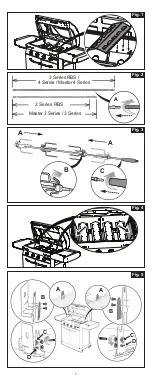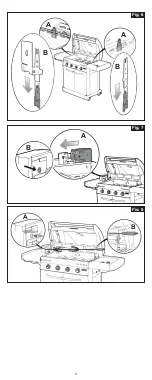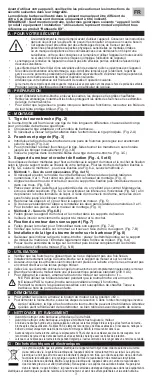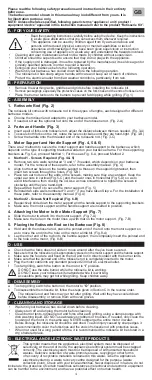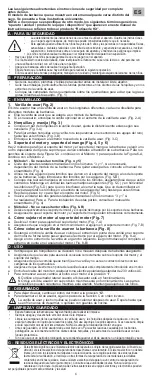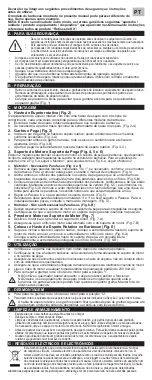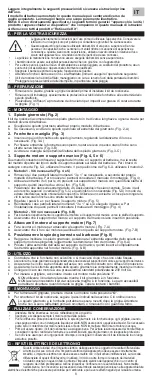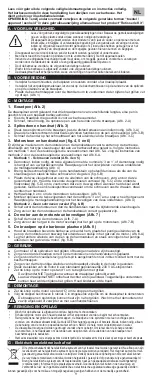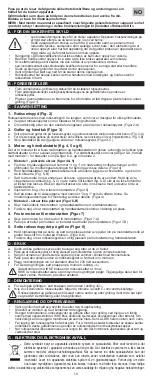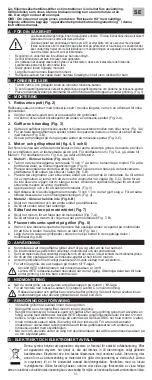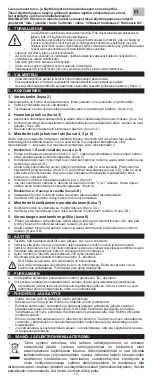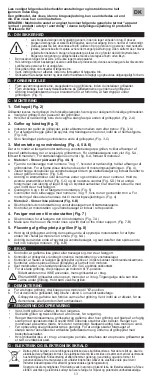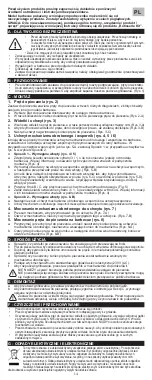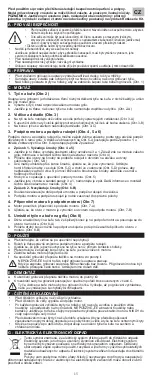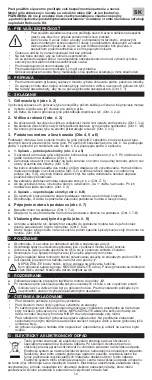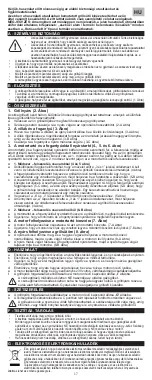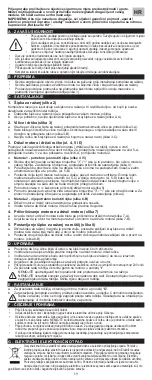
4
Please read the following safety precautions and instructions in their entirety
before use.
The barbecue model shown in this manual may look different from yours. It is
for illustration purpose only.
NOTE: Unless otherwise specified, following generic terms “appliance / unit / product /
equipment / device” appeared in this instruction manual all refer to the product “Rotisserie Kit”.
A - FOR YOUR SAFETY
• Read the operating instructions carefully before using the device. Keep the instructions
in a safe place afterwards so that you can access them whenever required.
• This appliance can be used by children aged from 8 years and above and
persons with reduced physical, sensory or mental capabilities or lack of
experience and knowledge if they have been given supervision or instruction
concerning use of appliance in a safe way and understand the hazards involved.
•
Cleaning and user maintenance shall not be made by children without supervision.
•
Children should be supervised to ensure that they do not play with the appliance.
•
If the supply cord is damaged, it must be replaced by the manufacturer, its service agent or
similarly qualified persons in order to avoid a hazard.
•
Extinguish your barbecue before the following operation.
•
Wait until your barbecue has cooled down before the following operation.
•
The rotisserie kit has sharp edges; handle with care and keep out of reach of children.
•
Protect the electrical outlet from bad weather conditions, particularly from rain.
B - PREPARATION
•
Remove the warming racks, griddles and grids before installing the rotisserie kit.
•
Remove packagings, especially the protective cases on the fork tines and the ends of rotisserie rod.
•
Place the burner tents onto the burners to prevent fat dripping while grilling. (Fig. 1)
C - ASSEMBLY
1. Rotisserie Rod (Fig. 2)
The rotisserie kit comes with rotisserie rod in three types of lengths, each designed for different
barbecue models.
a. Choose the rotisserie rod adapted to your barbecue model.
b. If needed, screw the optional rod onto the end of the rotisserie rod. (Fig. 2-A)
2. Forks and Handle (Fig. 3)
a. Insert a pair of forks onto rotisserie rod, adjust the distance between them as needed. (Fig. 3-A)
b. To secure both forks on the rod, rotate the levers clockwise until they are hand-tight. (Fig. 3-B)
c. Screw the handle onto the threaded end of the rotisserie rod. (Fig. 3-C)
3. Motor Support and Handle Support (Fig. 4, 5 & 6)
There are 2 methods to secure the motor support and handle support to the barbecue, which
depends on the type of supporting brackets welded on your barbecue frame. For the supporting
brackets as Fig. 5-A, proceed Method 1; For those as Fig. 6-A, proceed Method 2.
●
Method 1 - Screws Required (Fig. 4 & 5)
a. Remove two side walls numbered “3 and 1” if needed, which depends on your barbecue
model. For the removal of these parts, refer to the assembly manual. (Fig. 4)
b. Align both screw holes on the handle support to those on the supporting bracket, then
insert two screws through the holes. (Fig. 5-B)
c. Place two ear nuts over the ends of the screws, making sure they are centered. Keep the
upper ear nuts in vertical (Fig. 5-C) and the lower ones in horizontal (Fig. 5-D) so as to
avoid interference from closing the lid. Use a cross screwdriver to tighten the screws in
clockwise until they are hand-tight.
d. Repeat Step b and c to secure the motor support. (Fig. 5)
e. Reinstall two side walls numbered “3 and 1” if you have taken Step a. For the installation of
these parts, refer to the assembly manual. (Fig. 4)
●
Method 2 - Screws Not Required (Fig. 6-B)
a. Respectively slide down the motor support and the handle support to the supporting brackets.
b. Make sure the motor support and the handle support are inserted in position.
4. Attaching the Motor to the Motor Support (Fig. 7)
a. Slide the motor to attach it to the motor support. (Fig. 7-A)
b. Make sure the hole on the motor lines up with that on the motor support. (Fig. 7-B)
5. Placing the Rotisserie Rod on the Barbecue (Fig. 8)
a. Hold and tilt the rotisserie rod, place the pointed end of the rod onto the motor support so
as to move the end into the hole on the motor a little bit. (Fig. 8-A)
b. Lay the other end of the rod onto the handle support, then completely insert the pointed end
to the hole on the motor. (Fig. 8-B)
D - USE
a. Check that the forks does not slide or move around after they’ve been secured.
b. Make sure that the rotisserie rod is appropriately placed on the motor support and the handle support.
c.
Make sure the food are well fixed on the rod and not in direct contact with the burner tents.
d. Make sure that the pointed end of the rotisserie rod is completely inserted to the motor.
e. Plug the motor cable into any standard polarized 230 Volt AC electrical outlet.
f. To start grilling, switch the button on the motor to “
I
” position.
DO NOT use the side burner while the rotisserie kit is working.
DO NOT leave your rotisserie kit unattended while it is working.
Accessible parts may get hot while grilling. Keep children away.
E - DISASSEMBLY
a. To stop grilling, switch the button on the motor to “
O
” position.
b. To disassemble the rotisserie kit, follow the steps given in Section C in the reverse order.
The rotisserie rod and forks may get hot after grilling. Wait until they have cooled down
before disassembly, or remove them with oven gloves.
F - CLEANING AND STORAGE
•
Wait until your barbecue has cooled down before cleaning.
•
Always turn off and unplug the motor before cleaning.
•
Clean burner tents, rotisserie rod and forks after each grilling, using a damp sponge with
dish washing liquid. DO NOT use abrasive scrubbers or brushes. If needed, only clean the
housing of the motor in the same way. NEVER submerge the entire motor in water.
•
Before storage, the rotisserie kit should be well dried. To avoid injury caused by sharp edges, it
is recommended to cover the forks tines and the ends of rotisserie rod with protective cases.
•
When not used for a long period of time, it is recommended the rotisserie kit be stored in a
dry, sheltered place.
G - ELECTRICAL AND ELECTRONIC WASTE PRODUCTS
This symbol means that the appliance’s electrical system must be disposed of
selectively. At the end of its life, the appliance’s electrical system must be scrapped
correctly. The electrical system must not be disposed of with unsorted household
wastes. Selective collection of waste promotes reuse, recycling or other forms
of recovery of recyclable materials contained in this waste. Take the appliance’s
electrical system to a waste recovery centre designed for the purpose (waste
collection point). Check with your local authorities. Never dispose of in nature, do not
incinerate: the presence of certain hazardous substances in electrical and electronic equipment
can be harmful to the environment, and have a potential effect on human health.
GB


